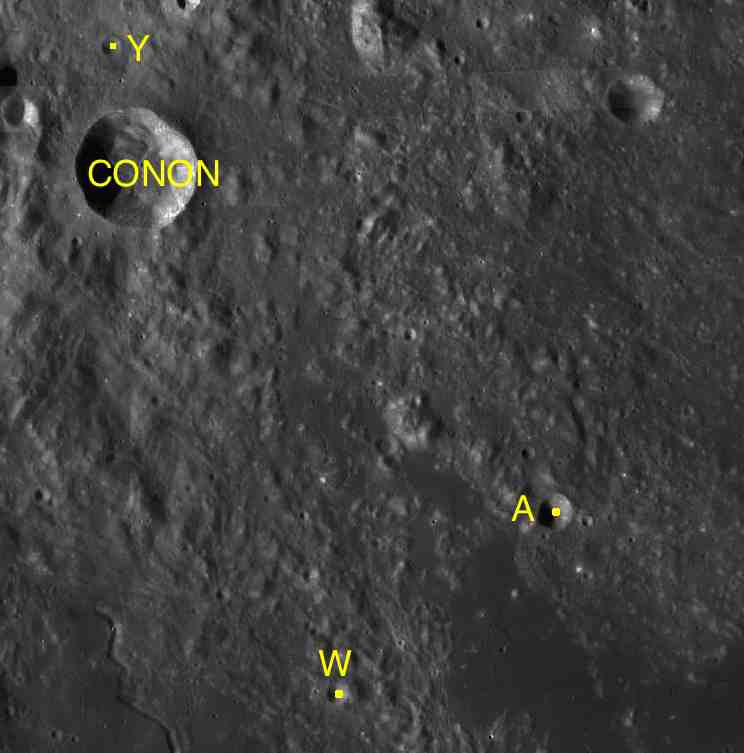Conon (crater) on:
[Wikipedia]
[Google]
[Amazon]
 Conon is a small but prominent
Conon is a small but prominent
 To the south, in the Sinus Fidei, is a sinuous
To the south, in the Sinus Fidei, is a sinuous

Conon at The Moon Wiki
LTO-41C1 Conon
&PI
 Conon is a small but prominent
Conon is a small but prominent lunar
Lunar most commonly means "of or relating to the Moon".
Lunar may also refer to:
Arts and entertainment
* ''Lunar'' (series), a series of video games
* "Lunar" (song), by David Guetta
* "Lunar", a song by Priestess from the 2009 album ''Prior t ...
impact crater
An impact crater is a depression (geology), depression in the surface of a solid astronomical body formed by the hypervelocity impact event, impact of a smaller object. In contrast to volcanic craters, which result from explosion or internal c ...
that lies in the eastern foothills of the Montes Apenninus
Montes Apenninus are a rugged mountain range on the northern part of the Moon's near side. They are named after the Apennine Mountains in Italy. With their formation dating back about 3.9 billion years, Montes Apenninus are fairly old.
Descri ...
mountain range. The crater is named for the Greek astronomer Conon of Samos
Conon of Samos (, ''Konōn ho Samios''; c. 280 – c. 220 BC) was a Greek astronomer and mathematician. He is primarily remembered for naming the constellation Coma Berenices.
Life and work
Conon was born on Samos, Ionia, and possibly died in Ale ...
( 250 BCE). Just to the west of Conon is the long mountain
A mountain is an elevated portion of the Earth's crust, generally with steep sides that show significant exposed bedrock. Although definitions vary, a mountain may differ from a plateau in having a limited summit area, and is usually higher t ...
ous ridge Mons Bradley
Mons Bradley is a lunar mountain massif in the Montes Apenninus range, along the eastern edge of the Mare Imbrium. It is located to the west of the crater Conon. To the west of this peak is the Rima Bradley rille. (See below.)
The selenographic ...
. The nearest craters possessing an eponym
An eponym is a noun after which or for which someone or something is, or is believed to be, named. Adjectives derived from the word ''eponym'' include ''eponymous'' and ''eponymic''.
Eponyms are commonly used for time periods, places, innovati ...
are Galen
Aelius Galenus or Claudius Galenus (; September 129 – AD), often Anglicization, anglicized as Galen () or Galen of Pergamon, was a Ancient Rome, Roman and Greeks, Greek physician, surgeon, and Philosophy, philosopher. Considered to be one o ...
, about to the east, and Aratus
Aratus (; ; c. 315/310 240 BC) was a Greek didactic poet. His major extant work is his hexameter poem ''Phenomena'' (, ''Phainómena'', "Appearances"; ), the first half of which is a verse setting of a lost work of the same name by Eudoxus of Cn ...
, about the same distance to the northeast.
Description
The edge of Conon's rim is sharply defined and has not received significant erosion from later impacts. The inner wall is somewhat variable in width, and the interior floor forms an irregular oval shape. This irregularity may be due to the rough and uneven surface on which the crater was formed. The floor is rough, but lacks a central prominence of note. To the south, in the Sinus Fidei, is a sinuous
To the south, in the Sinus Fidei, is a sinuous rille
Rille (German for 'groove') is typically used to describe any of the long, narrow depressions in the surface of the Moon that resemble channels. The Latin term is ''rima'', plural ''rimae''. Typically, a rille can be several kilometers w ...
that follows a course to the south-southeast. This rille is designated Rima Conon, and is named after this crater.
Satellite craters
By convention these features are identified on lunar maps by placing the letter on the side of the crater midpoint that is closest to Conon.
References
* * * * * * * * * * *External links
Conon at The Moon Wiki
LTO-41C1 Conon
&PI
topographic map
In modern mapping, a topographic map or topographic sheet is a type of map characterized by large- scale detail and quantitative representation of relief features, usually using contour lines (connecting points of equal elevation), but histori ...
Impact craters on the Moon
{{Craters on the Moon: C-F